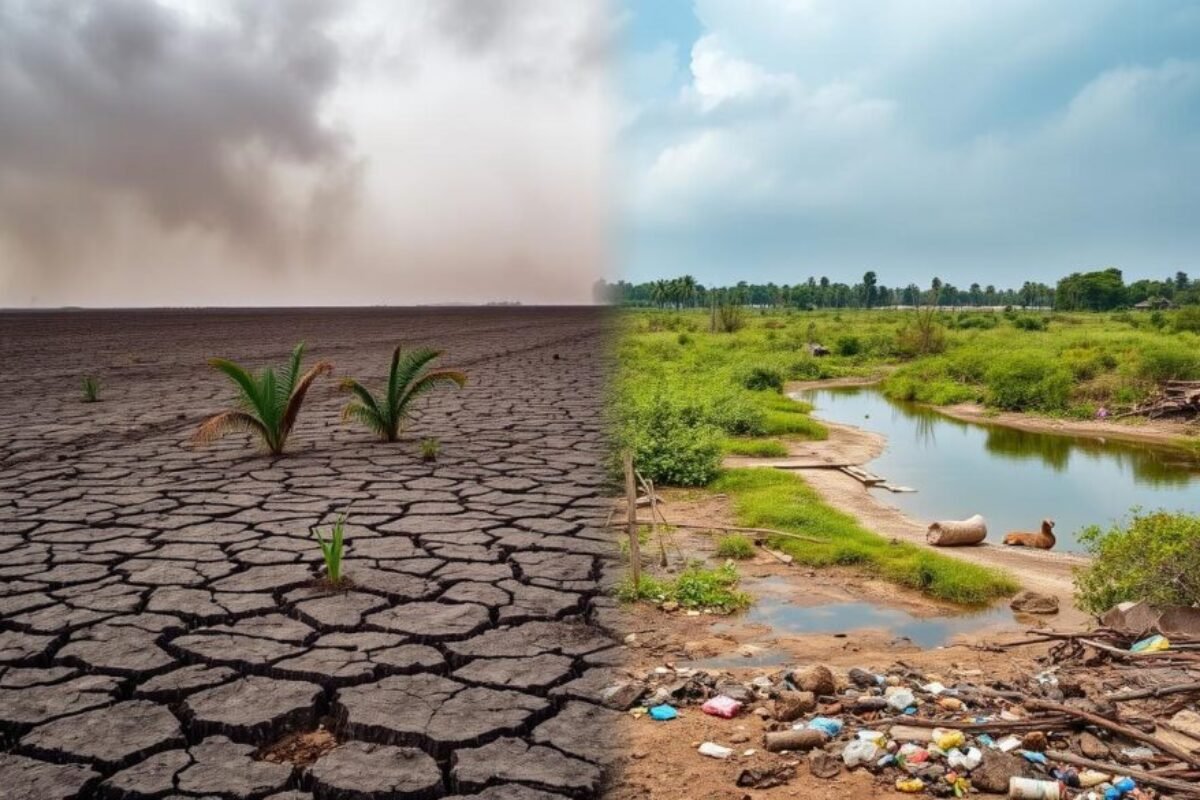Climate Change: Exploring the Challenges and Finding Solutions.
Did you know that human activities have increased carbon dioxide in the atmosphere more than ever before? Scientists say the warming we see today is all because of us1. This fact makes climate change a pressing issue that needs immediate action to protect our planet.
In 2015, leaders from around the world signed the Paris Agreement. They aimed to keep global warming under 2ºC, with a goal of 1.5°C1. This agreement shows how important it is for us to work together to solve climate problems. Rich countries also promised to give $100 billion each year to help poorer countries deal with climate change1.
Dealing with climate change requires a team effort. We need to consider the environment, economy, and society together. By understanding the full impact of climate change, we can find new ways to solve it. This includes using more solar and wind power and eating less meat and dairy1.
Key Takeaways
- The human-caused increase in carbon dioxide dramatically exceeds historic levels2.
- The 2015 Paris Agreement aims to limit global warming to 1.5ºC1.
- Rich countries have pledged $100 billion annually to help developing nations1.
- Transitioning to renewable energy sources is key for global climate solutions1.
- Understanding climate change requires integrating environmental, economic, and social factors.
Understanding Climate Change
Climate change is a major issue for our world. It means big changes in how hot or cold it gets and how weather patterns shift over time. Most of these changes are caused by things humans do.
Definition of Climate Change
Climate change includes natural and human-made factors that change our climate over long periods. From 2014 to 2023, the Earth’s temperature was about 1.2°C warmer than in the late 19th Century3. This warming has led to more extreme weather, melting ice, and warmer oceans3.
The amount of carbon dioxide in the air has gone up by over 40% compared to before humans started burning fossil fuels4. This has caused big changes in our environment4.
Human Activities Driving Climate Change
Human actions like burning fossil fuels, cutting down trees, and industrial activities are big causes of climate change. The amount of CO2 in the air has gone up by about 50% because of these actions3. Methane levels have also risen by more than 150%4.
These gases trap heat, making the Earth warmer. The year 2024 is expected to be the hottest year ever recorded3. This shows how urgent it is to stop these human activities.
Historical Context of Global Warming
To understand global warming, we must look at natural climate changes and human actions, like during the Industrial Revolution.
Natural Climate Variability
The Earth’s temperature has changed a lot over time. This is due to things like the sun’s rays and volcanoes. Even ancient Greeks thought humans could change the weather5.
In the 1820s, Joseph Fourier of France said that how energy comes in and out of Earth is key to the greenhouse effect5. Later, Svante Arrhenius of Sweden said doubling CO2 could raise temperatures by 5 degrees Celsius or 9 degrees Fahrenheit5.
From 1940 to 1970, Earth cooled due to pollution. But, the Keeling Curve showed CO2 levels rising from 1958, showing warming5.
Impact of the Industrial Revolution
The Industrial Revolution was a big change. It led to more greenhouse gases from burning fossil fuels. This made human activities the main cause of climate change from the 1800s6.
Today, Earth’s surface is about 1.2°C warmer than in the late 1800s6. The last decade was the warmest ever6.
Models from the 1960s said doubling CO2 would raise temperatures by 2 degrees Celsius5. In 1988, a hot summer in the US raised awareness. This led to the IPCC and climate agreements like the Paris Agreement5.
Human actions have greatly affected our climate. To fight global warming, we need to cut down on coal, oil, and gas use6.
The Science Behind Greenhouse Gases
Greenhouse gases play a key role in our atmosphere. They trap heat, causing the Earth to warm up. This is known as the greenhouse effect.
Main Greenhouse Gases
The main gases include carbon dioxide (CO2), methane (CH4), nitrous oxide (N2O), and fluorinated gases. CO2 and methane are the biggest culprits, mainly from human activities like energy use and farming. By 2023, CO2 levels had soared to over 420 parts per million, a 50 percent jump from before industrial times7. Methane was responsible for over 12 percent of U.S. emissions in 20217.
Sources of Carbon Dioxide and Methane
Burning fossil fuels for electricity and heat is the top source of CO2 emissions. This accounts for about 28 percent of U.S. emissions in 20217. The manufacturing sector is also a big contributor globally8. Deforestation and land use changes cause about a quarter of global emissions8.
Methane comes mainly from farming, like livestock and manure. In the U.S., farming was responsible for 10 percent of emissions in 20217. Methane warms the planet more than CO2, making it a key area for reduction.
Reducing CO2 and methane emissions is vital to fight climate change. Knowing where these gases come from helps us plan better for a sustainable future.
Global Temperature Rise and Its Effects
The world has seen a big jump in temperature over the years. Climate monitoring shows big changes. The global average surface temperature has gone up by about 2 degrees Fahrenheit (1 degree Celsius) from the pre-industrial era.
This rise means more heat overall. It shows a fast warming rate, speeding up a lot after the 20th century started9. In 2023, every month was among the seven warmest on record. June to December were the hottest months ever9.
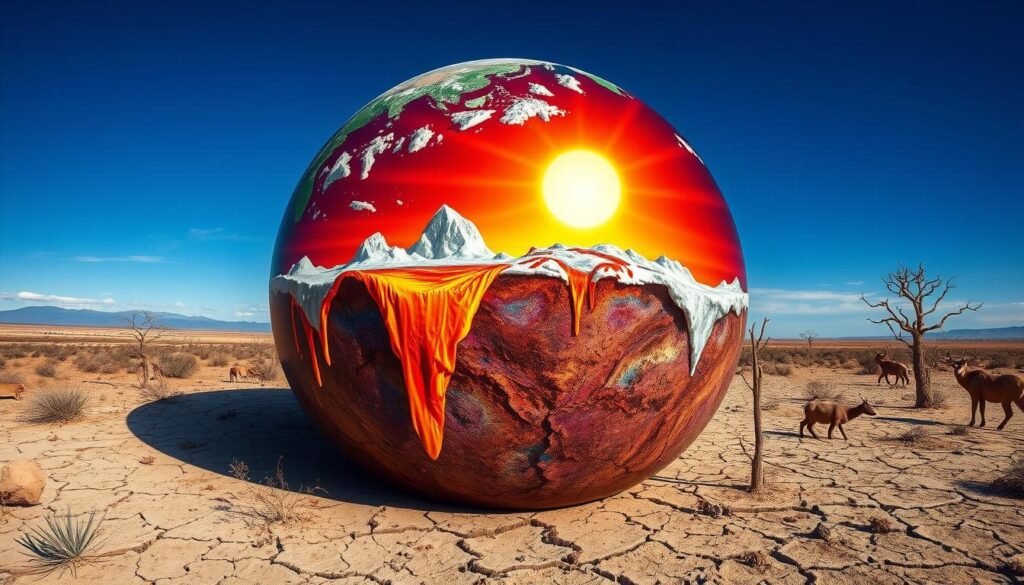
Temperature Records and Trends
The warming rate has been much faster in recent decades than in the early 1900s9. 2023 was the warmest year on record for land and oceans, and for both hemispheres. This shows how human actions, like greenhouse gas emissions, affect the temperature.
The land and ocean temperature has risen by 0.11° Fahrenheit (0.06° Celsius) per decade on average. But it has warmed faster, by 0.36° Fahrenheit (0.20° Celsius) per decade, from 198210. If we keep emitting carbon dioxide at current rates, temperatures could rise by 5 to 10.2 degrees Fahrenheit by 2100 compared to the 1901-1960 average11.
Regional Temperature Variations
Regional climate effects are big and different. For example, Wisconsin has seen a 2 degrees Fahrenheit increase and a 14 percent increase in precipitation. This is most noticeable in winter and summer10.
Wisconsin is expected to warm by 2 to 8 degrees Fahrenheit by 2050. Winter temperatures could rise by 5 to 11 degrees10. Extreme rainfall events have also increased by 31 percent in the Great Lakes region from 1958 to 2007. This trend is expected to continue10.
These changes show how different parts of the world face climate changes at different rates. This affects ecosystems and human societies in various ways.
Environmental Impact of Climate Change
Climate change affects our environment in big ways. It harms ecosystems and biodiversity and makes ice melt faster, raising sea levels. These changes have big effects on nature and our lives.
Effects on Ecosystems and Biodiversity
Climate change is causing a big loss of biodiversity. The last decade was the warmest ever, with temperatures rising by 1.19 to 1.22°C. This has messed up many ecosystems12.
Droughts have made plants grow 3% less each year12. Rising sea temperatures are killing off plankton and marine mammals13.
Melting Polar Ice and Sea-Level Rise
The melting of ice caps and rising sea levels are big threats. The Arctic Ocean is losing ice fast, losing 31,100 square miles a year14. This ice loss is causing sea levels to rise by 8–9 inches on average14.
If we don’t stop emissions, sea levels could rise by 6.6 feet by 210013. This will hurt coastal areas and marine life. The US might see a one-foot sea level rise by 205013.
Knowing these impacts shows we need to act fast to fight climate change. We must work together to protect our planet’s biodiversity and ecosystems.
Human Impact and Vulnerability
Climate change harms human health, the economy, and social structures. It’s important to understand the wide range of challenges it brings.
Health Risks and Safety Concerns
Climate change affects many, including children, pregnant women, and older adults. It also impacts people with disabilities and those with chronic conditions. Poverty, racial bias, and lack of healthcare worsen health disparities15.
Extreme heat can make health problems worse. Weather changes can spread diseases like malaria and dengue fever15.
We must work with communities to address these health issues. Vulnerability assessments help improve adaptation and resilience15. More research is needed to understand and tackle these challenges.
Economic and Social Disruptions
Climate change increases poverty and affects food security. A World Bank report says it could push 68 to 135 million into poverty by 203016. In Afghanistan, 80% of people rely on agriculture, facing food insecurity due to climate change16.
Higher temperatures could add 189 million to the hungry population if it rises by 2°C16. A $500 billion stimulus package aims to reduce economic disparities caused by climate change16.
Migratory and Conflict Risks
Climate migration is a growing concern, with over 20 million people relocating yearly. This migration can lead to resource competition and conflict16.
The Great Green Wall in Africa’s Sahel aims to restore land, sequester carbon, and create jobs by 203016. Women and girls face high security risks from water scarcity, linked to violence and early marriage16.
The Role of Renewable Energy
Renewable energy is key in fighting climate change and reducing fossil fuel use. By adding renewable sources to our energy mix, we can move towards a greener future.
Solar and Wind Energy
It leads to renewable energy progress. Solar power costs have dropped by 85 percent from 2010 to 2020. Wind energy costs have fallen by 56 percent for onshore and 48 percent for offshore17.
Investment firm Lazard reports wind and solar costs have plummeted by 58 percent and 78 percent from 200918.
Now, renewables provide 29 percent of global electricity. This number is expected to grow with more investments and tech advancements17. By 2030, renewables could meet 65 percent of global electricity needs17. The International Energy Agency says we need at least $4 trillion in renewable energy investments by 2030 to hit net-zero emissions by 205019.
Hydropower and Nuclear Power
They are also vital in renewable energy. Hydropower has long been a clean energy source. Nuclear power will also play a big role in reaching net-zero emissions.
States like Texas and Iowa rely heavily on wind energy. Texas gets over 45 percent of its energy from wind, and Iowa gets 31 percent18.
The IMF notes $5.9 trillion was spent on fossil fuels in 2020. This shows the financial and environmental costs of fossil fuel use19. Renewables offer economic benefits, like creating more jobs and saving money from pollution17. In the US, renewables supported nearly 200,000 jobs and saved $5.2 billion in health benefits18.
As we grow renewable energy projects, research and development are key. The private sector and government policies will help us reach clean energy’s full promise.
Strategies for Reducing Carbon Footprint
Addressing climate change needs a big plan to cut our carbon footprint. One key way is to make things more energy efficient everywhere.
Energy Conservation Methods
Using less energy is a big help in cutting carbon. For example, making buildings more energy-smart can cut down on heating and cooling needs by up to 40%20. Heat pumps are also super efficient, using less energy than old water heaters20.
We also suggest using electric appliances like heat pump dryers. They use about 28% less energy than regular dryers20.
Switching to renewable energy is also key. New York State aims to get 70% of its power from green sources by 203020. This move helps save energy and supports long-term goals. The EU has made great strides, with 24.1% of energy coming from renewables by 202321.
Sustainable Farming Practices
In farming, using green practices is essential for the planet and sustainable agriculture. These methods help lower harmful emissions. In the EU, emissions have only dropped by 5% from 2005 to 2022, but there’s hope for more cuts21.
Practices like crop rotation and organic fertilizers can help. So can agroforestry, which combines trees with farming. These steps can make farming less harmful to the environment.
Also, cutting down on food waste is a big win for the planet. Throwing away food creates methane, a gas that’s bad for the climate20. By wasting less and composting more, we can reduce methane emissions.
| Strategy | Potential Impact | Example |
|---|---|---|
| Building Weatherization | Reduces HVAC energy use by 40% | Insulation, air leak sealing |
| Utilizing Heat Pumps | 2-3 times more energy efficient | For heating and cooling |
| All-Electric Appliances | 28% less energy consumption | Heat pump dryers |
| Sustainable Agriculture | Reduction in non-CO₂ emissions | Crop rotation, organic fertilizers |
| Reducing Food Waste | Reduces methane emissions | Composting systems |
Climate Adaptation and Resilience
Climate change is a growing concern, making climate adaptation and resilience planning more urgent than ever. Adaptation strategies help ecosystems and communities deal with current and future climate impacts. They ensure these groups can survive and thrive.
Adapting to Current and Future Impacts
The Intergovernmental Panel on Climate Change (IPCC) defines adaptation as adjusting to climate effects. This can include big projects like seawalls or smaller steps like growing different crops for extreme weather22. But, big projects might reduce ‘response diversity’ due to the ‘sunk-cost effect’22. It’s key to mix immediate fixes with long-term plans for better resilience.
Protecting Vulnerable Communities
Helping vulnerable communities is a key part of climate adaptation and resilience. Quick fixes like technology and management can offer immediate help22. But, deeper changes are needed for lasting resilience22. For example, early warning systems and more green spaces in cities can help communities bounce back from climate shocks23.
Resilience thinking promotes planning that looks at all aspects of a community. It aims to boost social, human, natural, physical, and financial strengths22.
By focusing on climate adaptation, resilience planning, and community safety, we can create measures that protect and empower communities. These efforts help communities face future climate challenges. The mix of mitigation, adaptation, and resilience planning shapes how ready we are for climate events23.
| Strategy | Description | Examples |
|---|---|---|
| Adaptation | Adjusting to climate change effects | Sea level rise defenses, crop diversification |
| Resilience Planning | Preparing and recovering quickly from impacts | Early warning systems, urban green spaces |
| Community Safeguarding | Protecting the most vulnerable populations | Targeted emergency responses, capacity building |
International Initiatives and Agreements
Global climate agreements are key in fighting climate change. The Paris Agreement and the UNFCCC are major examples. They aim to reduce greenhouse gas emissions and promote international cooperation.
Paris Agreement
The Paris Agreement was signed in 2015. It aims to keep the global temperature rise under 2°C and try to limit it to 1.5°C24. Almost every country agreed to cut carbon emissions and improve their ability to adapt to climate change. Even though the US left in 2020, President Joe Biden’s return shows its lasting importance24.
- Countries Involved: 196
- Long-term Goals: Net-zero emissions by 2050
- Mechanism: Nationally Determined Contributions (NDCs)
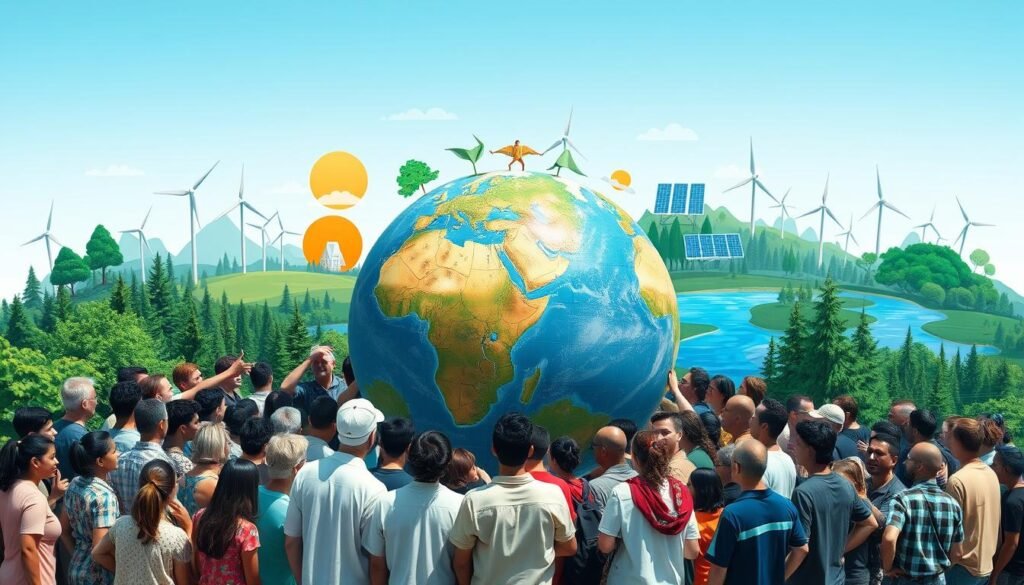
United Nations Framework Convention on Climate Change (UNFCCC)
The UNFCCC was ratified by 197 countries in 1992. It laid the groundwork for global climate action. The UNFCCC created the annual Conference of the Parties (COP) for climate talks and cooperation24.
Through the UNFCCC, agreements like the Kyoto Protocol and the Paris Agreement were made. They built on the UNFCCC’s initial goals.
The UNFCCC helps countries work together on climate change. Its goal is to keep greenhouse gas levels stable to avoid dangerous climate changes. The Montreal Protocol’s success in reducing ozone-depleting substances shows what international agreements can achieve24.
- Key Committees: IPCC, COP
- Major Agreements: Kyoto Protocol, Paris Agreement
These global agreements are always being reviewed, like the IPCC’s reports. The 2021 IPCC report warns that we will hit 1.5°C of warming in the next 20 years. This shows we need to keep working on climate action2425.
| Agreement | Year Enacted | Key Objectives |
|---|---|---|
| Montreal Protocol | 1987 | Eliminate ozone-depleting substances |
| UNFCCC | 1992 | Stabilize greenhouse gas concentrations |
| Kyoto Protocol | 2005 | Reduce emissions by 5% below 1990 levels |
| Paris Agreement | 2015 | Limit temperature increase to below 2°C |
The Importance of Immediate Climate Action
It’s critical to address climate urgency to protect our economy and health now and in the future. Climate solutions offer more than just environmental benefits. They also create jobs, boost economic growth, and ensure long-term stability.
Economic Benefits of Climate Solutions
Climate action not only lessens future impacts but also boosts the economy. The World Bank says air pollution costs the world US$8.1 trillion each year, or 6.1% of global GDP26. Cutting air pollution could save a million lives by 2050, saving healthcare costs and boosting the economy.
Investing in clean tech like solar and wind is key to reducing CO2 and promoting sustainable growth. These investments create jobs, boost energy independence, and drive innovation27. We also need to tackle short-lived pollutants like black carbon and methane to prevent deaths and crop losses28.
Long-term Consequences of Inaction
Ignoring climate urgency will lead to severe economic and health problems. The World Health Organization predicts 250,000 more deaths yearly from 2030 to 2050 due to climate-related health issues26. Direct health costs could hit US$4 billion annually by 203026.
Climate change will also disrupt economies worldwide, causing extreme weather, higher food prices, and more27. Environmental damage and natural disasters will worsen, threatening resources like the Amazon rainforest27. Reducing short-lived pollutants can prevent 0.6°C of warming by 2050, showing the urgent need for action28.
In summary, immediate climate action is essential for both the environment and the economy. By acting now, we can protect our health and economy, avoiding the severe consequences of inaction.
Technological Innovations in Climate Mitigation
Advances in climate technology are key to fighting global warming. High-performance computing for climate research is a major innovation. It uses powerful computers to better understand climate changes.
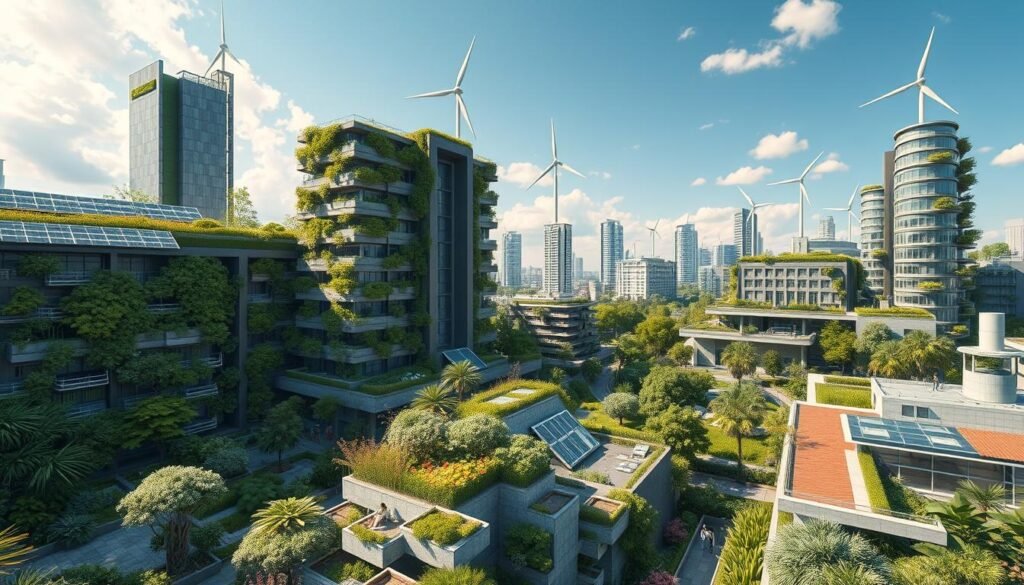
High Performance Computing for Climate Research
High-performance computing (HPC) is vital for climate research. It helps create detailed climate models. These models predict future climates with more accuracy.
Scientists use these models to study Earth’s climate systems. They look at factors that change the climate. Almost half of the needed emission cuts come from new technologies29.
Only 26 out of 1,200 IPCC scenarios limit warming to 1.5 degrees using known tech29.
Carbon Capture and Storage (CCS)
Carbon Capture and Storage (CCS) is another big innovation. It captures CO2 from plants and stores it underground. This prevents it from entering the atmosphere.
Despite its promise, CCS is not scaling up fast. Only one CCS facility exists at an iron and steel plant, and none at a cement plant29. This shows we need more investment in CCS.
| Sector | Percentage of Implementation | References |
|---|---|---|
| Transportation | 75% | Chen, L., et al. (2019) |
| Manufacturing | 90% | Finlay, M., et al. (2017) |
| Construction | 70% | Gupta, S., et al. (2021) |
| Electronics | 85% | Hernandez, J., et al. (2019) |
CCS is not the only solution. Fast tech advancements help industries go green. For example, 75% of transport companies use climate tech to cut emissions.
Also, 90% of energy-efficient investments in manufacturing have lowered emissions30. And 70% of construction uses sustainable building thanks to new tech30.
Technological innovations are key to fighting climate change. By improving climate research and CCS, we can cut emissions and move towards a green future.
Financial Investments in Climate Action
Investing in climate action is key to fighting climate change. Governments and private sectors have important roles. Also, helping developing countries financially is essential for a fair climate plan.
Government and Private Sector Roles
In 2021, climate finance hit USD 1 trillion for the first time, about 1% of global GDP31. But, we need to increase it five times by 2030 to tackle climate change31. Renewable energy and transport get 73% of the investment, showing where private help is needed31.
Private money is becoming more important, making up 51% of the funds31. But, sectors like agriculture and industry, big polluters, get less than 4% of the funds31. We must invest more in these areas to balance things out.
Supporting Developing Countries
Helping developing countries with climate finance is critical for a fair transition. In 2022, developed countries gave $115.9 billion, meeting their goal32. But, adaptation finance only reached $32.4 billion, short of the COP26 goal32.
By 2030, emerging markets and developing countries, except China, need $2.4 trillion a year32. About $1 trillion must come from international finance, both public and private, to reach these goals32.
| Year | Total Climate Finance | Adaptation Finance | Source of Largest Funding |
|---|---|---|---|
| 2021 | USD 1 trillion31 | USD 63 billion31 | Loans32 |
| 2022 | USD 115.9 billion from developed countries32 | USD 32.4 billion32 | Loans32 |
Climate Change: Exploring the Challenges and Finding Solutions
The world faces huge climate challenges today. But, with new solutions and a team effort, we can tackle global warming and build a sustainable future. In 2015, leaders signed the Paris Agreement to fight climate change. They aimed to keep warming under 2ºC, ideally at 1.5ºC1.
Yet, big industries like banks and car companies often put money over the planet. Companies like BP and Shell spend a lot to slow down climate action1. But, nature helps by cleaning up emissions through projects and trees that soak up carbon dioxide1.
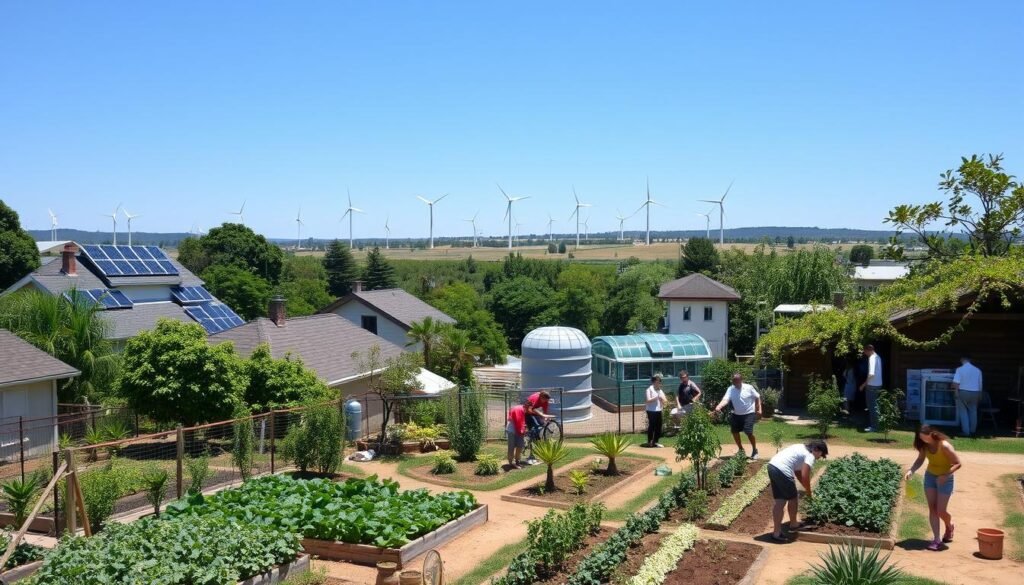
Global temperatures have risen by about 2°F (1.1°C) from 1850. Sea levels and Arctic ice have also seen big changes14. In the U.S., storms are getting stronger, and droughts are growing, mainly in the West14. So, we need global teamwork to change polluting sectors’ ways1.
Rich countries promised $100 billion a year to help poor countries fight climate change. But, this money is not yet given1. We must all choose green energy, use public transport, and eat less meat and dairy to cut our carbon footprint1.
We must turn promises into real plans. Governments and businesses must work together to cut emissions fast1. Using new tech and funding green practices will help us change for the better.
Conclusion
As we wrap up our deep dive into climate change, it’s clear that working together is key. We face a choice: keep going down the current path or choose a greener future. If we keep warming below 1.5°C, we might save 70-90 percent of coral reefs and cut sea levels by 10 cm by 210033.
To achieve this, we need to cut global carbon emissions by 45 percent by 2030. Our goal is to reach ‘net zero’ by 205033.
The need for climate action is now more pressing than ever. Together, we can lower emissions, potentially from a 16 percent increase in 2015 to just 3 percent today33. Climate-smart agriculture is a powerful tool to tackle these issues. It helps rural areas, improves smallholder lives, and fights against migration and land loss34.
Looking to the future, our actions will shape our planet’s sustainability. It’s vital for governments, businesses, communities, and individuals to join forces. With 3.3 to 3.6 billion people at risk, our goal is clear: make our world resilient and sustainable for the next generation33.
By taking urgent, coordinated action and finding new solutions, we can protect our planet for everyone.
